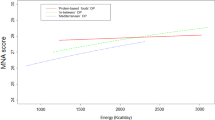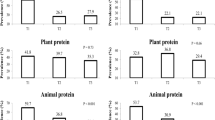Abstract
Objectives
The present paper is an attempt to understand ethnic variations in the association of dietary intake with body composition in two geographically and genetically diverse adult populations, i.e., Santhal, an indigenous group from the plain regions of eastern India and Monpa, an indigenous population from the high-altitude regions of north-eastern India.
Methods
A total number of 200 adult Monpa and 204 adult Santhal were recruited for the present investigation, which was conducted in phases. Multiple and multivariate regression frameworks were used in the paper to evaluate the influence of dietary intake on body composition.
Results
In somatotype, the Santhal were found to be predominantly mesomorphic, whereas the Monpa were predominantly endomorphic, irrespective of their gender. Similarly, significantly (p < 0.001) greater percentages of overweight and obese individuals were found among the Monpa, but not among the Santhal.
Conclusions
Despite the fact that both these tribes are engaged in primitive technology-based agriculture that requires a lot of physical labour, such difference in their body composition could be due to fundamental differences in the physical environment and great dietary/nutritional intake. In fact, it was found that Monpa follow a daily diet that is highly rich in dairy fat and animal protein, as compared to their counterpart Santhal. Santhal’s daily diet generally consists of rice and boil vegetables, with protein consumption as low as once or twice a month. However, despite these differences the paper revealed no significant influence of dietary intake on the body composition of these populations. Hence, an adaptive approach is proposed to understand the substantial proportion of body composition variations in these two ethnically diverse populations.
This is a preview of subscription content, access via your institution
Access options
Subscribe to this journal
Receive 12 print issues and online access
$259.00 per year
only $21.58 per issue
Buy this article
- Purchase on Springer Link
- Instant access to full article PDF
Prices may be subject to local taxes which are calculated during checkout



Similar content being viewed by others
Data availability
The data that support the findings of this study are available from the corresponding author upon reasonable request.
References
Sun J, Buys NJ, Hills AP. Dietary pattern and its association with the prevalence of obesity, hypertension and other cardiovascular risk factors among Chinese older adults. Int J Environ Res Public Health. 2014;11:3956–71.
He Y, Li Y, Lai J, Wang D, Zhang J, Fu P, et al. Dietary patterns as compared with physical activity in relation to metabolic syndrome among Chinese adults. Nutr, Metab Cardiovascular Dis. 2013;23:920–8.
Paradies Y, Harris R, Anderson I. The impact of racism on Indigenous health in Australia and Aotearoa: towards a research agenda. Cooperative Research Centre for Aboriginal Health; 2008.
Wirfält E, Drake I, Wallström P. What do review papers conclude about food and dietary patterns? Food Nutr Res. 2013;57:20523.
Guyenet SJ, Schwartz MW. Regulation of food intake, energy balance, and body fat mass: implications for the pathogenesis and treatment of obesity. J Clin Endocrinol Metab. 2012;97:745–55.
Kahleova H, Levin S, Barnard ND. Vegetarian dietary patterns and cardiovascular disease. Prog Cardiovasc Dis. 2018;61:54–61.
Eshriqui I, Folchetti LD, Valente AM, de Almeida-Pititto B, Ferreira SR. Breastfeeding duration is associated with offspring’s adherence to prudent dietary pattern in adulthood: results from the Nutritionist’s Health Study. J Dev Orig health Dis. 2020;11:136–45.
Livingstone KM, McNaughton SA. Dietary patterns by reduced rank regression are associated with obesity and hypertension in Australian adults. Br J Nutr. 2017;117:248–59.
Barua S. Mating patterns among the Dirang Monpa of West Kameng District, Arunachal Pradesh. Curr Anthropol. 1986;27:188–90.
Culshaw WJ. Tribal heritage: a study of the Santals. London: HRAF Publication, Ethnology Collection; 1998. http://ets.umdl.umich.edu/cgi/e/ehraf/ehraf-idx.1949.
Martin R, Saller K. Lehrbuch der Anthropooigie. Stuttgart: Gustav Fischer Verlag; 1957.
Carter JE. The Heath-Carter somatotype method. San Diego State University, Department of Physical Education; 1975.
Heath BH, Carter JL. A modified somatotype method. Am J Phys Anthropol. 1967;27:57–74.
Ghosh S, Dosaev T, Prakash J, Livshits G. Quantitative genetic analysis of the body composition and blood pressure association in two ethnically diverse populations. Am J Phys Anthropol. 2017;162:701–14.
Consultation WE. Appropriate body-mass index for Asian populations and its implications for policy and intervention strategies. Lancet. 2004;363:157–63.
Siri WE. Body composition from fluid spaces and density: analysis of methods. 1956.
Durnin JV, Womersley JV. Body fat assessed from total body density and its estimation from skinfold thickness: measurements on 481 men and women aged from 16 to 72 years. Br J Nutr. 1974;32:77–97.
Indian Council of Medical Research (ICMR). Nutrient requirements and recommended dietary allowances for Indians. New Delhi: Indian Council of Medical Research; 2010.
Misra PJ, Mini GK, Thankappan KR. Risk factor profile for non-communicable diseases among Mishing tribes in Assam, India: results from a WHO STEPs survey. Indian J Med Res. 2014;140:370.
Lalnuneng A, Khongsdier R. Rural-urban differences in hypertension among the Hmars of Manipur in Northeast India. Anthropologist. 2017;28:173–83.
Tushi A, Rao SR, Pattabi K, Kaur P. Prevalence of risk factors for non-communicable diseases in a rural tribal population of Mokokchung, Nagaland, India. Natl Med J India. 2018;31:11.
Mungreiphy NK, Kapoor S, Sinha R. Association between BMI, blood pressure, and age: study among Tangkhul Naga tribal males of Northeast India. J Anthropol. 2011;2011:1–7.
Maken T, Varte LR. Anthropometric indicators as predictors of high blood pressure among the Ao tribe of North-East India. Asian J Med Sci. 2013;4:14–22.
Baro DM, Dihingia MP. Comparative study of selected anthropometric measurements and physical fitness between hills and plain area people. J Int Acad Res Multidiscip. 2014:2:1–7.
Singh R. Nutritional anthropometric measurements of male Tamil clerks in Madras (sea coast plains) and Ooty (hills). Ann Hum Biol. 1975;2:301–4.
Gautam RK, Thakur R. Biosocial correlates of nutrition and chronic energy deficiency among adult females of two ecological zones in Madhya Pradesh and Uttarakhand, India. Malays J Nutr. 2009;15:137–153.
Tseng M, DeVillis RF. Correlates of the “western” and “prudent” diet patterns in the us. Ann Epidemiol. 2000;10:481–2.
Fonseca MJ, Gaio R, Lopes C, Santos AC. Association between dietary patterns and metabolic syndrome in a sample of Portuguese adults. Nutr J. 2012;11:1–9.
Smith FA, Betancourt JL, Brown JH. Evolution of body size in the woodrat over the past 25,000 years of climate change. Science. 1995;270:2012–4.
Angilletta MJ, Cooper BS, Schuler MS, Boyles JG. The evolution of thermal physiology in endotherms. Front Biosci E. 2010;2:861–81.
Blanckenhorn WU. Die Evolution der Körpergrösse und des geschlechtlichenGrössendimorphismus. Vierteljahrsschr der Naturforschenden Ges Zürich. 2002;147:99–106.
Mayr E. Geographical character gradients and climatic adaptation. Evolution. 1956;10:105–8.
Goudie RI, Ankney CD. Body size, activity budgets, and diets of sea ducks wintering in Newfoundland. Ecology. 1986;67:1475–82.
Paterson JD. Comment—Bergmann’s rule is invalid: a reply to V. Geist. Can J Zool. 1990;68:1610–2.
McDowall RM. On size and growth in freshwater fish. Ecol Freshw Fish. 1994;3:67–79.
Steudel K, Porter WP, Sher D. The biophysics of Bergmann’s rule: a comparison of the effects of pelage and body size variation on metabolic rate. Can J Zool. 1994;72:70–7.
Atkinson D, Sibly RM. Why are organisms usually bigger in colder environments? Making sense of a life history puzzle. Trends Ecol Evol. 1997;12:235–9.
Katzmarzyk PT, Leonard WR. Climatic influences on human body size and proportions: ecological adaptations and secular trends. Am J Phys Anthropol. 1998;106:483–503.
Ivanhoe F, Chu PW, Bennyhoff JA. Archaeological Amerindian and Eskimo cranioskeletal size variation along coastal Western North America: relation to climate, the reconstructed diet high in marine animal foods, and demographic stress. Int J Osteoarchaeol. 1998;8:135–79.
Fukase H, Wakebe T, Tsurumoto T, Saiki K, Fujita M, Ishida H. Geographic variation in body form of prehistoric Jomon males in the Japanese archipelago: its ecogeographic implications. Am J Phys Anthropol. 2012;149:125–35.
Wells JC. Ecogeographical associations between climate and human body composition: analyses based on anthropometry and skinfolds. Am J Phys Anthropol. 2012;147:169–86.
Foster F, Collard M. A reassessment of Bergmann’s rule in modern humans. PLoS ONE. 2013;8:e72269.
Calder, WA. Size, function, and life history. Courier Corporation; Dover Publications, Inc., Mineola, New York, USA. 1996.
Lindstedt SL, Boyce MS. Seasonality, fasting endurance, and body size in mammals. Am Naturalist. 1985;125:873–8.
Blackburn TM, Gaston KJ, Loder N. Geographic gradients in body size: a clarification of Bergmann’s rule. Diversity Distrib. 1999;5:165–74.
Cushman JH, Lawton JH, Manly BF. Latitudinal patterns in European ant assemblages: variation in species richness and body size. Oecologia. 1993;95:30–7.
Paterson JD. Coming to America: acclimation in macaque body structures and Bergmann’s rule. Int J Primatol. 1996;17:585–611.
Ghosh S. Understanding chronic energy deficiency among population living under limited nutritional resources. Coll Antropol. 2017;41:327–34.
Acknowledgements
SG gratefully acknowledges the financial support rendered by the Ministry of Tribal Affairs, Government of India and by the University Grant Commission (UGC) Raman Post Doctoral fellowship to Indian for studying in Syracuse University, NY, USA.
Author information
Authors and Affiliations
Contributions
SG contributed the study design, collected the data and performed the statistical analyses along with writing the manuscript.
Corresponding author
Ethics declarations
Competing interests
The author declares no competing interests.
Ethical approval
All the participants gave written informed consent according to the guidelines established by the institutional ethics committees of North-Eastern Hill University and University of Delhi, India.
Additional information
Publisher’s note Springer Nature remains neutral with regard to jurisdictional claims in published maps and institutional affiliations.
Supplementary information
Rights and permissions
About this article
Cite this article
Ghosh, S. A comparative analysis of dietary intake and body composition among two ethnically distinct tribal populations from India. Eur J Clin Nutr 76, 1423–1431 (2022). https://doi.org/10.1038/s41430-022-01121-6
Received:
Revised:
Accepted:
Published:
Issue Date:
DOI: https://doi.org/10.1038/s41430-022-01121-6



